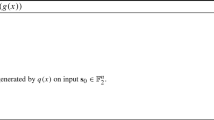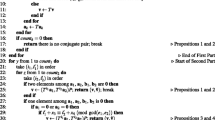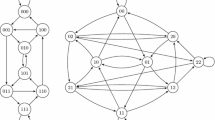Abstract
The focus of this work is to show how to combine Zech’s logarithms and each of the cycle joining and cross-join pairing methods to construct binary de Bruijn sequences. Basic implementations are supplied as proofs of concept. The cycles, in the cycle joining method, are typically generated by a linear feedback shift register. We prove a crucial characterization that determining Zech’s logarithms is equivalent to identifying conjugate pairs shared by any two distinct cycles. This speeds up the task of building a connected adjacency subgraph that contains all vertices of the complete adjacency graph. Distinct spanning trees in either graph correspond to cyclically inequivalent de Bruijn sequences. As the cycles are being joined, guided by the conjugate pairs, we track the changes in the feedback function. We show how to produce certificates of existence for spanning trees of certain types to conveniently handle large order cases. The characterization of conjugate pairs via Zech’s logarithms, as positional markings, is then adapted to identify cross-join pairs. A modified m-sequence is initially used, for ease of generation. The process can be repeated on each of the resulting de Bruijn sequences. Most prior constructions in the literature measure the complexity of the corresponding bit-by-bit algorithms. Our approach is different. We aim first to build a connected adjacency subgraph that is certified to contain all of the cycles as vertices. The ingredients are computed just once and concisely stored. Simple strategies are offered to keep the complexities low as the order grows.


Similar content being viewed by others
Notes
The tables for characteristic 2 are included in the current standard distribution as well as in the online calculator for \(n \le 300\).
References
van Aardenne-Ehrenfest T, de Bruijn NG. Circuits and trees in oriented linear graphs. Simon Stevin. 1951;28:203–17.
Arndt J. Matters computational: ideas, algorithms, source code. 1st ed. New York: Springer; 2010.
Bosma W, Cannon J, Playoust C. The Magma algebra system. I. The user language. J Symb Comput. 1997;24(3–4):235–65.
Broder A. Generating random spanning trees. In: 30th annual symposium on foundations of computer science, 1989; 1989. p. 442–7.
de Bruijn NG. A combinatorial problem. Koninklijke Nederlandse Akademie v Wetenschappen. 1946;49:758–64.
Chang Z, Ezerman MF, Fahreza AA. On greedy algorithms for binary de Bruijn sequences. Appl Algebra Eng Commun. (2020) [Online]. https://doi.org/10.1007/s00200-020-00459-3
Chang Z, Ezerman MF, Ling S, Wang H. On binary de Bruijn sequences from LFSRs with arbitrary characteristic polynomials. Des Codes Cryptogr. 2019;87(5):1137–60.
Compeau P, Pevzner P, Tesler G. How to apply de Bruijn graphs to genome assembly. Nat Biotechnol. 2011;29(11):987–91.
Coppersmith D, Rhoades RC, VanderKam JM. Counting de Bruijn sequences as perturbations of linear recursions. CoRR. 2017. arXiv:1705.07835.
Ding C. Codes from difference sets. Singapore: World Scientific; 2014.
Dong J, Pei D. Construction for de Bruijn sequences with large stage. Des Codes Cryptogr. 2017;85(2):343–58.
Dragon PB, Hernandez OI, Sawada J, Williams A, Wong D. Constructing de Bruijn sequences with co-lexicographic order: the k-ary Grandmama sequence. Eur J Comb. 2018;72:1–11.
Dubrova E. A scalable method for constructing Galois NLFSRs with period \(2^n-1\) using cross-join pairs. IEEE Trans Inf Theory. 2013;59(1):703–9.
Etzion T, Lempel A. Algorithms for the generation of full-length shift-register sequences. IEEE Trans Inf Theory. 1984;30(3):480–4.
Ezerman MF, Fahreza AA. A binary de Bruijn sequence generator from Zech’s logarithms. 2017. https://github.com/adamasstokhorst/ZechdB.
Ezerman MF, Fahreza AA. A binary de Bruijn sequence generator from product of irreducible polynomials. 2018. https://github.com/adamasstokhorst/debruijn.
Fredricksen H. A class of nonlinear de Bruijn cycles. J Comb Theory Ser A. 1975;19(2):192–9.
Fredricksen H. A survey of full length nonlinear shift register cycle algorithms. SIAM Rev. 1982;24(2):195–221.
Golomb SW. Shift register sequences. Laguna Hills: Aegean Park Press; 1981.
Golomb SW, Gong G. Signal design for good correlation: for wireless communication, cryptography, and radar. New York: Cambridge University Press; 2004.
Hauge ER, Helleseth T. De Bruijn sequences, irreducible codes and cyclotomy. Discret Math. 1996;159(1–3):143–54.
Hauge ER, Mykkeltveit J. On the classification of de Bruijn sequences. Discret Math. 1996;148(1–3):65–83.
Helleseth T, Kløve T. The number of cross-join pairs in maximum length linear sequences. IEEE Trans Inf Theory. 1991;37(6):1731–3.
Huang Y. A new algorithm for the generation of binary de Bruijn sequences. J Algorithms. 1990;11(1):44–51.
Huber K. Some comments on Zech’s logarithms. IEEE Trans Inf Theory. 1990;36(4):946–50.
Hume MA, Barrera LA, Gisselbrecht SS, Bulyk ML. UniPROBE, update 2015: new tools and content for the online database of protein-binding microarray data on protein-DNA interactions. Nucleic Acids Res. 2014;43(D1):D117–22.
Jacobi C. Über die kreistheilung und ihre anwendung auf die zahlentheorie. J Reine Angew Math. 1846;30:166–82.
Jansen CJA, Franx WG, Boekee DE. An efficient algorithm for the generation of de Bruijn cycles. IEEE Trans Inf Theory. 1991;37(5):1475–8.
Knuth DE. The art of computer programming. Combinatorial algorithms. Part 1, vol. 4A. Upper Saddle River: Addison-Wesley; 2011.
Lempel A. On a homomorphism of the de Bruijn graph and its applications to the design of feedback shift registers. IEEE Trans Comput. 1970;C-19(12):1204–9.
Lidl R, Niederreiter H. Finite fields. Encyclopaedia of mathematics and its applications. New York: Cambridge University Press; 1997.
Mandal K, Gong G. Cryptographically strong de Bruijn sequences with large periods. In: Knudsen LR, Wu H, editors. Selected areas in cryptography. Berlin: Springer; 2013. p. 104–18.
Menezes AJ, Vanstone SA, Oorschot PCV. Handbook of applied cryptography. 1st ed. Boca Raton: CRC Press Inc; 1996.
Mykkeltveit J, Szmidt J. On cross joining de Bruijn sequences. Contemp Math. 2015;632:333–44.
Robshaw M, Billet O, editors. New stream cipher designs. Berlin: Springer; 2008.
Samatham MR, Pradhan DK. The de Bruijn multiprocessor network: a versatile parallel processing and sorting network for VLSI. IEEE Trans Comput. 1989;38(4):567–81.
Sawada J, Williams A, Wong D. Generalizing the classic greedy and necklace constructions of de Bruijn sequences and universal cycles. Electron J Comb. 2016;23(1):1–24.
Sloane NJA. The online encyclopedia of integer sequences: Mersenne exponents, primes \(p\) such that \(2^{p}-1\) is (Mersenne) prime. https://oeis.org/A000043.
Sloane NJA. The online encyclopedia of integer sequences: triangle T read by rows. https://oeis.org/A281123.
Stevens B, Williams A. The coolest way to generate binary strings. Theory Comput Syst. 2014;54(4):551–77.
Storer T. Cyclotomy and difference sets., Lectures in advanced mathematics. Chicago: Markham Pub. Co.; 1967.
Yang B, Mandal K, Aagaard MD, Gong G. Efficient composited de Bruijn sequence generators. IEEE Trans Comput. 2017;66(8):1354–68.
Acknowledgements
M. F. Ezerman gratefully acknowledges the hospitality of the School of Mathematics and Statistics of Zhengzhou University, in particular Prof. Yongcheng Zhao, during several visits. The work of Z. Chang is supported by the National Natural Science Foundation of China Grant 61772476 and the Key Scientific Research Projects of Colleges and Universities in Henan Province Grant 18A110029. Grants TL-9014101684-01 and MOE2013-T2-1-041 support the research carried out by M. F. Ezerman, S. Ling, and H. Wang. Singapore Ministry of Education Grant M4011381 provides a partial support for A. A. Fahreza. J. Szmidt’s work is funded by the Polish Ministry of Science and Higher Education, Decision no. 6663/E-294/S/2018.
Author information
Authors and Affiliations
Corresponding author
Ethics declarations
Ethical Statements
The authors declare that they have no conflict of interest.
Additional information
Publisher's Note
Springer Nature remains neutral with regard to jurisdictional claims in published maps and institutional affiliations.
Rights and permissions
About this article
Cite this article
Chang, Z., Ezerman, M.F., Fahreza, A.A. et al. Binary de Bruijn Sequences via Zech’s Logarithms. SN COMPUT. SCI. 2, 314 (2021). https://doi.org/10.1007/s42979-021-00683-9
Received:
Accepted:
Published:
DOI: https://doi.org/10.1007/s42979-021-00683-9




